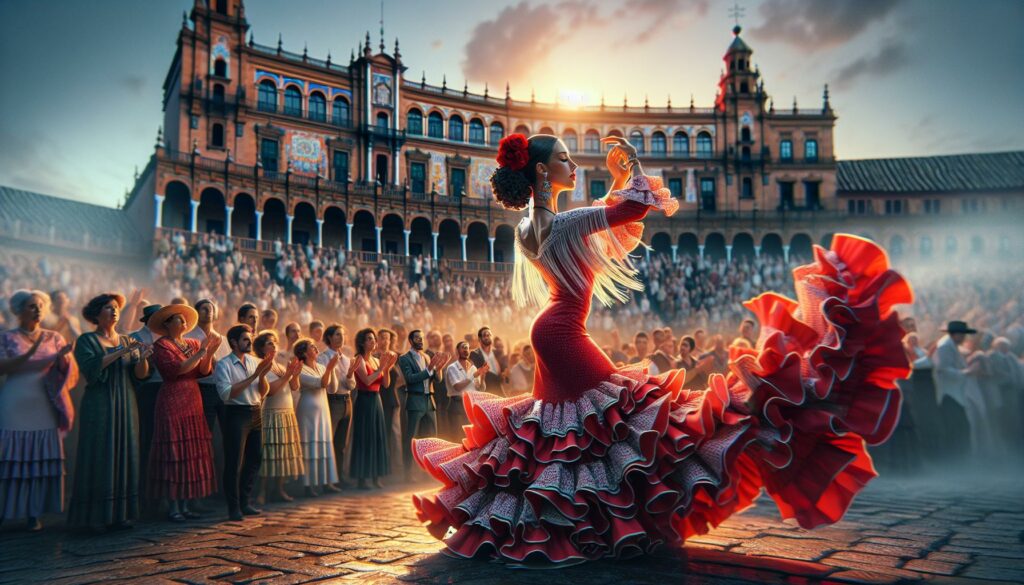As I’ve explored the vibrant streets of Spain, I’ve discovered that cultural activities in Spain here aren’t just entertainment – they’re a way of life. From the passionate flamenco performances in Seville to the mouth-watering food festivals in Barcelona, Spanish culture pulses through every corner of this magnificent country.
After spending years immersed in Spain’s rich traditions, I can tell you that each region offers its own unique blend of art music and celebrations. Whether it’s joining locals for tapas in Madrid’s bustling markets or witnessing the thrilling Running of the Bulls in Pamplona you’ll find countless opportunities to experience authentic Spanish culture firsthand. I’m excited to share my favorite cultural experiences that’ll help you truly understand what makes Spain’s heritage so special.
Key Takeaways
- Spain’s cultural calendar is dominated by iconic festivals like La Tomatina and Running of the Bulls, which attract thousands of participants annually and showcase unique Spanish traditions
- The country’s artistic heritage is preserved in world-renowned museums like the Prado and Reina Sofía, featuring masterpieces from Spanish legends including Velázquez, Goya, and Picasso
- Flamenco remains a cornerstone of Spanish cultural expression, combining singing (cante), dance (baile), and guitar playing (toque) in authentic performances throughout Andalusia
- Spanish gastronomy centers around tapas culture and regional wine production, with areas like Rioja and Ribera del Duero producing internationally acclaimed wines
- Traditional crafts and local markets, such as Madrid’s El Rastro and Valencia’s Mercado Central, continue to preserve Spain’s artisanal heritage through ceramics, textiles, and handmade goods
Cultural Activities in Spain
Spanish festivals combine centuries-old traditions with modern celebrations, creating unique cultural experiences. I’ve discovered these events showcase Spain’s rich heritage through vibrant displays of music, food, art.
La Tomatina Festival
La Tomatina transforms Buñol, Valencia into a massive tomato battlefield every last Wednesday of August. I’ve witnessed more than 20,000 participants throw 150,000 tomatoes in this hour-long food fight that turns the streets completely red. The festival requires participants to squish tomatoes before throwing them to prevent injury, ensuring a safe yet exhilarating experience.
Running of the Bulls
Pamplona’s San Fermín festival features the iconic Running of the Bulls from July 7-14 each year. I’ve observed six bulls and six steers race through an 875-meter course alongside hundreds of runners dressed in traditional white clothing with red scarves. The morning runs start at 8 AM sharp when rockets signal the release of the bulls from their corral.
- Daily fireworks displays called “”mascletà”” at 2 PM in Plaza del Ayuntamiento
- Traditional parades featuring participants in historical costumes
- Food stalls serving authentic Valencian paella
- Nightly street parties with live music performances
| Festival | Location | Date | Participants |
|---|---|---|---|
| La Tomatina | Buñol | Last Wednesday of August | 20,000+ |
| Running of the Bulls | Pamplona | July 7-14 | 2,000+ daily |
| Las Fallas | Valencia | March 15-19 | 1M+ visitors |
Spanish Art and Architecture
Spain’s artistic heritage spans centuries of influential movements, featuring masterpieces from renowned artists like Goya, Velázquez, and Picasso. I’ve explored countless museums, galleries, and architectural marvels that showcase Spain’s creative evolution from medieval times to modern day.
Famous Museums and Galleries
The Prado Museum in Madrid houses over 8,600 paintings and 700 sculptures, including Las Meninas by Velázquez. I discovered the Museo Reina Sofía’s collection of 20th-century art, featuring Picasso’s Guernica and works by Salvador Dalí. The Guggenheim Museum Bilbao displays contemporary art in its distinctive titanium-clad building, attracting 1.2 million visitors annually.
| Museum | Location | Key Works |
|---|---|---|
| Prado Museum | Madrid | Las Meninas, Garden of Earthly Delights |
| Reina Sofía | Madrid | Guernica, The Persistence of Memory |
| Guggenheim | Bilbao | The Matter of Time, Puppy |
Gothic and Moorish Architecture
Spain’s architectural landscape blends Islamic and Christian influences, evident in landmarks like the Alhambra Palace in Granada. The Sagrada Familia in Barcelona showcases Antoni Gaudí’s modernist interpretation of Gothic architecture, while the Mezquita in Córdoba combines Islamic arches with a Catholic cathedral. The Royal Palace of Madrid exemplifies Spanish Baroque style with 3,418 rooms decorated with frescoes, porcelain, and tapestries.
| Architectural Site | Style | Period |
|---|---|---|
| Alhambra Palace | Moorish | 13th-14th century |
| Sagrada Familia | Modernist Gothic | 1882-present |
| Mezquita | Islamic-Gothic | 8th-16th century |
| Royal Palace | Baroque | 18th century |
Spanish Music and Dance
Spanish musical heritage combines passionate rhythms with diverse regional influences, creating a distinctive cultural identity. I’ve discovered that each region contributes unique elements to Spain’s rich musical tapestry.
Flamenco Culture
Flamenco embodies the soul of Spanish music through its three core elements: cante (singing), baile (dance), and toque (guitar playing). The art form originated in Andalusia, where I’ve witnessed authentic performances in tablaos across Seville and Granada. Professional flamenco dancers execute precise footwork and dramatic arm movements while wearing traditional traje de flamenca costumes. Top flamenco venues include:
- Casa de la Memoria in Seville hosts nightly 75-minute performances
- Tablao El Arenal features 15 performers during each show
- Cueva de la Rocío in Granada offers intimate cave performances
Regional Folk Music Traditions
Spain’s musical diversity extends beyond flamenco through distinct regional styles:
- Galicia’s gaita (bagpipes) accompanies traditional muñeira dances
- Catalonia’s sardana involves circular group dances with 10-12 participants
- Basque Country’s txalaparta uses wooden planks as percussion instruments
- Valencia’s dolçaina (double-reed instrument) leads festival processions
| Festival | Location | Month | Attendance |
|---|---|---|---|
| Festival Internacional del Cante de las Minas | La Unión | August | 50,000 |
| Festival de Ortigueira | Galicia | July | 100,000 |
| Festa Major de Gràcia | Barcelona | August | 250,000 |
Spanish Gastronomy and Food Culture
Spanish cuisine integrates regional ingredients, cooking methods, and social traditions that span centuries of cultural evolution. I’ve experienced firsthand how food connects people through shared meals, local markets, and culinary traditions across Spain’s diverse regions.
Tapas Culture
Tapas represents Spain’s distinctive approach to dining, featuring small portions served throughout the evening. I’ve discovered these essential elements of authentic tapas dining:
- Raciones accommodate 2-3 people with larger portions than individual tapas
- Pintxos, popular in the Basque Country, consist of ingredients mounted on bread slices
- Traditional tapas include patatas bravas, jamón ibérico, croquetas de jamón
- El Tardeo occurs between 4-8 PM when locals gather for tapas crawls
- Many bars serve complimentary tapas with drink orders in Granada, León, and Almería
- Rioja produces oak-aged reds from Tempranillo grapes across 65,000 hectares
- Ribera del Duero specializes in full-bodied reds from high-altitude vineyards
- Priorat offers intense wines from ancient vines growing in volcanic soil
- Jerez creates distinctive sherries through the solera aging system
- Penedès leads Spain’s cava production with 95% of sparkling wine output
| Wine Region | Signature Grape | Annual Production (Million Liters) |
|---|---|---|
| Rioja | Tempranillo | 250 |
| Ribera del Duero | Tinto Fino | 54 |
| Priorat | Garnacha | 6 |
| Jerez | Palomino | 35 |
| Penedès | Xarel·lo | 380 |
Modern Cultural Events
Spain’s contemporary cultural scene thrives with innovative events that celebrate creativity. Here’s my exploration of the most significant modern cultural gatherings across the country.
Film Festivals
The San Sebastián International Film Festival leads Spain’s cinematic calendar each September, drawing 150,000+ attendees to witness premieres from established directors and emerging talents. I’ve experienced the Málaga Film Festival’s dedication to Spanish cinema each March, featuring 200+ screenings across multiple venues. The Sitges Film Festival transforms this Mediterranean town into the world’s premier fantasy and horror film destination every October, showcasing 300+ genre films to 180,000 visitors.
| Art Fair | Location | Annual Visitors | Participating Galleries |
|---|---|---|---|
| ARCO | Madrid | 100,000 | 200+ |
| LOOP Fair | Barcelona | 50,000 | 50+ |
| Estampa | Madrid | 25,000 | 75+ |
| ART Madrid | Madrid | 20,000 | 40+ |
Traditional Crafts and Markets
I’ve discovered that cultural activities in spain traditional crafts showcase centuries of artisanal expertise through handmade ceramics leather goods tapestries wooden crafts. These crafts remain vibrant in local markets artisan workshops across the country.
Ceramic Making
Spanish ceramic production centers primarily in regions like Valencia Toledo Manises where artisans create distinctive pieces using traditional methods. The ceramic workshops in Talavera de la Reina produce intricate blue-and-white pottery featuring geometric patterns floral designs dating back to the 16th century. Master potters in Granada craft azulejos (decorative tiles) using techniques passed down through generations creating pieces that adorn buildings fountains patios throughout Spain.
Local Artisan Markets
Spain’s artisan markets operate in specific schedules locations offering authentic handcrafted goods:
- El Rastro in Madrid operates every Sunday from 9 AM to 3 PM featuring 3500+ vendors
- Las Dalias Hippy Market in Ibiza runs Saturdays year-round showcasing 200 local artisans
- Mercado de Artesanía in Barcelona opens daily in Las Ramblas displaying ceramic jewelry leather goods
- Mercado Central de Valencia combines fresh produce with traditional craft stalls operating Monday through Saturday
| Market Type | Items | Location | Operating Hours |
|---|---|---|---|
| Street Markets | Ceramics Textiles | City Centers | Morning to Afternoon |
| Indoor Bazaars | Leather Goods Jewelry | Historic Districts | All Day |
| Seasonal Fairs | Regional Specialties | Town Squares | Festival Periods |
| Craft Villages | Traditional Workshops | Rural Areas | By Appointment |
A Cultural Tapestry
Spain’s cultural tapestry has left an indelible mark on my heart. From the rhythmic passion of flamenco to the architectural marvels that dot the landscape I’ve discovered a nation where tradition and modernity dance in perfect harmony.
I’ve come to understand that cultural activities in Spain culture isn’t just about watching performances or visiting museums – it’s a way of life that pulses through every street corner cafe and festival gathering. The warmth of shared meals the joy of celebration and the pride in preserving age-old traditions create an enchanting cultural mosaic that I’ll always treasure.
Whether you’re an art enthusiast food lover or culture seeker Spain offers countless opportunities to immerse yourself in authentic experiences that will transform your perspective and create lasting memories.



